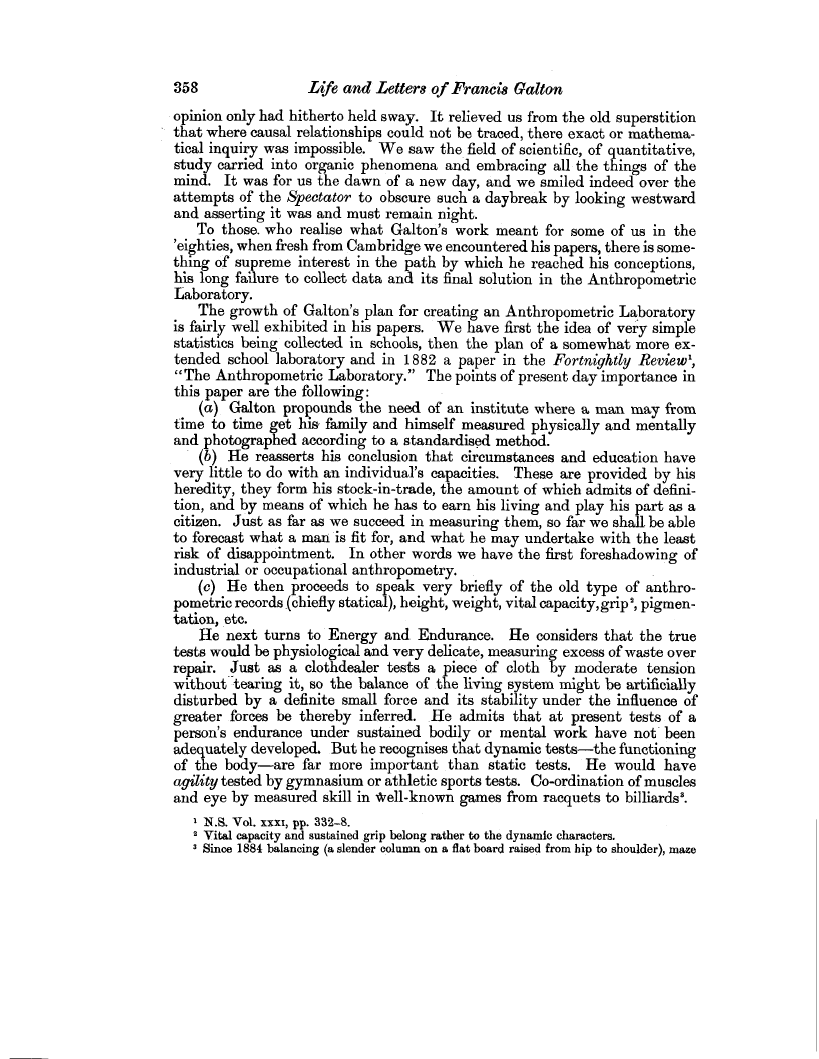358 Life and Letters of Francis Galton
opinion only had hitherto held sway. It relieved us from the old superstition that where causal relationships could not be traced, there exact or mathematical inquiry was impossible. We saw the field of scientific, of quantitative, study carried into organic phenomena and embracing all the things of the mind. It was for us the dawn of a new day, and we smiled indeed over the attempts of the Spectator to obscure such a daybreak by looking westward and asserting it was and must remain night.
To those. who realise what Galton's work meant for some of us in the 'eighties, when fresh from Cambridge we encountered his papers, there is something of supreme interest in the path by which he reached his conceptions, his long failure to collect data and its final solution in the Anthropometric Laboratory.
The growth of Galton's plan for creating an Anthropometric Laboratory is fairly well exhibited in his papers. We have first the idea of very simple statistics being collected in schools, then the plan of a somewhat more extended school laboratory and in 1882 a paper in the Fortnightly Review`, "The Anthropometric Laboratory." The points of present day importance in this paper are the following:
(a) Galton propounds the need of an institute where a man may from time to time get his- family and himself measured physically and mentally and photographed according to a standardised method.
(b) He reasserts his conclusion that circumstances and education have very little to do with an individual's capacities. These are provided by his heredity, they form his stock-in-trade, the amount of which admits of definition, and by means of which he has to earn his living and play his part as a citizen. Just as far as we succeed in measuring them, so far we shall be able to forecast what a man is fit for, and what he may undertake with the least risk of disappointment. In other words we have the first foreshadowing of industrial or occupational anthropometry.
(c) He then proceeds to speak very briefly of the old type of anthropometric records.(chiefly statical), height, weight, vital capacity, grip 2, pigmentation, etc.
He next turns to Energy and Endurance. He considers that the true tests would be physiological and very delicate, measuring excess of waste over repair. Just as a clothdealer tests a piece of cloth by moderate tension without tearing it, so the balance of the living system might be artificially disturbed by a definite small force and its stability under the influence of greater forces be thereby inferred. He admits that at present tests of a person's endurance under sustained bodily or mental work have not ' been adequately developed. But he recognises that dynamic tests-the functioning of the body-are far more important than static tests, He would have agility tested by gymnasium or athletic sports tests. Co-ordination of muscles and eye by measured skill in *ell-known games from racquets to billiards$.
I N.S. Vol. xxxi, pp. 332-8.
2 Vital capacity and sustained grip belong rather to the dynamic characters.
3 Since 1884 balancing (a slender column on a flat board raised from hip to shoulder), maze

